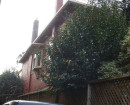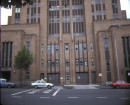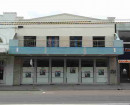UNITING CHURCH
2A LAUREL STREET GOLDEN SQUARE, GREATER BENDIGO CITY
-
Add to tour
You must log in to do that.
-
Share
-
Shortlist place
You must log in to do that.
- Download report



Statement of Significance
The Uniting Church at Golden Square was built between 1870 and 1873 to replace an earlier church. In March 1852 James "Jimmy" Jeffrey, a digger, had preached on a tree stump near the site of the present church in Golden Square. In the same year, Rev Symons, stationed at Castlemaine, purchased a modest timber building at Golden Square which was the first Wesleyan Methodist church in Bendigo. This was replaced in 1859 by a larger stone building. Eventually the congregation outgrew this church and plans were made for a new one.
The architects Crouch and Wilson designed the church, with Messrs Johns and Hinley as the contractors. The foundation stone was laid by mining entrepreneur Richard Allingham on 5 January 1870. The church was built in two stages - the first section built at the rear of the existing stone church was opened for worship on 11 May 1870. The additions were advanced enough for services to be held early in 1872 and the building was finally completed in 1873. The church is a large Gothic style building in bichromatic brick with a slate roof. It is dominated by a corner tower with bellcast eaves surmounted by a tapering spire and a five-light Decorated Gothic west window. There are two porches on either side and a vestry at the east end. A chimney rises from the vestry.
The Uniting Church, Golden Square is of architectural and historical significance to the state of Victoria.
The church is architecturally significant as a representative and intact example of a church by Crouch and Wilson, one of the most influential ecclesiastical and organisational firm of architects in Victoria in the 1860s and 1870s. It is dominated by a corner tower with bellcast eaves surmounted by a tapering spire and a five-light Decorated Gothic west window. The interior demonstrates fine craftsmanship in its carved walnut pulpit flanked on either side by a flight of steps and adorned by a wrought iron balustrade and the similar wrought iron sanctuary railing; the gallery with its cast iron balustrading; and the ceiling trusses and the fluted columns.
The church has historical associations with the Wesleyan church in Victoria and its scale and quality demonstrates the strength of the denomination in the goldfields. Built to accommodate over 1200 people and known as the "cathedral of Methodism", for many years this church dominated the surrounding landscape.
-
-
UNITING CHURCH - History
Contextual History:History of Place:
Wesleyan Methodism began in the mid-eighteenth century in England through the evangelical preaching of John and Charles Wesley, clergymen of the Church of England. Although remaining within the established church, John Wesley organised his followers into religious societies, introduced a system of itinerant and local preachers and developed an organisation governed by an annual conference. It was not until four years after Wesley’s death in 1795, the Methodists broke away from the Church of England to become a separate denomination. The Methodists opposed the Calvinistic doctrine of predestination and election; believing instead in universal redemption and the doctrine of Christian perfection. Some groups broke away from the main Wesleyan Methodist Society to form other divisions, including the Methodist New Connexion, the Primitive Methodist Connexion and the Bible Christians.
The Wesleyan movement coincided with the Industrial Revolution in England and made its biggest impact on the burgeoning industrialised working masses. The notion that salvation was available to everyone, including the poor, appealed to those from the mining and manufacturing towns of Britain who had become increasingly alienated from the established church. They were particularly attracted by the notion of spiritual equality between cleric and layman, whereby certain laymen were able to perform most of the functions of an ordained minister. This allowed the organisational genius John Wesley to form a circuit system whereby several lay preachers served the local communities, whilst ordained ministers would oversee the circuit, administering sacraments as required. Able to rely on unordained preachers, the Wesleyan Methodists established themselves easily in the goldfields where they became the strongest denomination.
Methodism was introduced in Port Phillip from the earliest years of European settlement. Before the Rev Joseph Orton held the first Methodist service by a clergyman in 1836, lay people already gathered in homes for prayer and worship. The first church was built on the north-west corner of Swanston Street and Flinders Lane in 1839.
History of Place:
In March 1852 James “Jimmy” Jeffrey, a digger, preached on a tree stump near the site of the present church in Golden Square. In the same year, Rev Symons, stationed at Castlemaine, purchased a modest timber building at Golden Square which was the first Wesleyan Methodist church in Bendigo. The building also served both as a Sunday school and day school.
The years after 1852 saw tremendous growth and changes in the economic and social fabric of Bendigo. As tents gave away to more permanent dwellings, all the trappings of a more settled society became evident. Mining developed into a major industry with the rise of quartz mining and a class of capitalists grew. Many of these entrepreneurs, including Richard Allingham, played important roles in the Methodist congregation at Golden Square.
By 1859 the small timber church at Golden Square was “bursting at the seams” and a new stone church was built and opened on 11 December 1859. However it was not long before a larger building was required to cope with the expanding congregation. Some members of the congregation were suspicious of anything that smacked of extravagance and favoured the design of an austere, barn-like church. However, the views of Richard Allingham, responsible for planning and negotiating the new building, prevailed and a building was approved which would be worthy of its prime purpose, worthy of the growing town and worthy of the generations unborn.
The architects Crouch and Wilson designed the church, with Messrs Johns and Hinley as the contractors. The foundation stone was laid by Mr Allingham on 5 January 1870. The church was built in two stages - the first section built at the rear of the existing stone church. This part was opened for worship on 11 May 1870, the occasional sermon being preached by the Rev Joseph Dare.
The additions were advanced enough for services to be held early in 1872 and on 6 April 1872 an opening function took place. On 2 September 1872 another ceremony was conducted to lay a memorial stone at the ecclesiastical south west of the church.. The building was finally completed in 1873. The total cost was about £4000, the sum being raised by donations from affluent and ordinary members of the congregation. At the time of its construction and for some time after, the church could lay claim to be the grandest church on the goldfield. This “cathedral of Methodism” as it was called soared above the surrounding mining landscape.
The church has seen few alterations throughout its history. The most significant change has been with the organ and choir. The organ was by Robert Mackenzie in 1874. Originally the organ stood in a loft above the pulpit behind a balustrade. In 1885 the organ underwent extensive repairs and alterations. The Bendigo architect W.C. Vahland was engaged to make structural alterations for the organ loft to accommodate the rebuilt organ. This work involved extending the gallery which had originally been three-sided and installing another balustrade in front of the choir. The current timber railing in front of the choir was installed in the 1950s.
The narthex, comprising a glassed-in section at the west end of the building, was created in 1962. The three stained glass windows, a gift of Fletcher Jones, replaced the original plain ones in the lower part of the west wall.
The Golden Square church complex should be considered in the context of Wesleyan architecture and the work of Crouch and Wilson. The church was built after the Methodists had moved away from John Wesley's original concept of the church as a "plain and decent" preaching-house to an acceptance of more elaborate and substantial Gothic style structures with the construction of the Lonsdale Street Wesleyan Church in 1857. Previously, the Gothic style had been shunned for its papist associations. Nevertheless, the Methodist churches were usually distinguished from Roman Catholic and Anglican churches by their layout. Preaching was central to the Methodist service, as was hymn singing, and this is often reflected in an auditory style interior with an emphasis on the pulpit and the pipe organ and choir gallery.
Thomas Crouch was a prolific ecclesiastical architect, on his own, or more often in the partnership of Crouch and Wilson. Most of the churches he designed were for the Methodists, however he did design churches for other denominations. He used a variety of materials, mostly cheaper ones such as brick instead of stone.
Other examples of the work of Crouch and Wilson include:
Uniting Church (Former Congregational), 246 Malvern Road, Armadale, 1858 (H1022). This bluestone church with cement detailing is architecturally important as one of the earliest designs of the firm Crouch and Wilson, one of the most influential in ecclesiastical and institutional architecture in the 1860s and 1870s.
Uniting Church, cnr Sydney Road and Bell Street, Coburg, 1858 (H962). One of three early examples of a Gothic style Methodist church in Victoria, the others being in Lonsdale Street, Melbourne and Fitzroy Street, St Kilda.
St John’s Wesleyan Church, cnr Electra and Pasco Streets, Williamstown, 1876. This bluestone church with yellow brick and cement details includes twin doorways with unusual hood mouldings.
Former Wesleyan Church, 79-81 Hesse Street, Queenscliff, 1888. Designed by T.J. Crouch, this brick church has a main facade with tripartite lancets and a projecting porch.
Former Wesleyan Methodist Church, Central Springs Road, Daylesford, 1865. This church is also dominated by a square tower surmounted by a long tapering spire, although this spire is in brick.
Other Wesleyan Methodist churches on the Heritage Register include:
Uniting Church, cnr Sydney Road and Bell Street, Coburg, chapel: 1849-57 (H962). The earliest known surviving Methodist chapel in Victoria. Its simple design is representative of the early Methodist churches reflecting John Wesley’s belief in “plain and decent” preaching houses.
Wesley Church, 124-144 Lonsdale Street, Melbourne, 1857-58 (H12). Designed by Joseph Reed, this church is of great significance in the history of Wesleyan Methodism and in the development of Victorian church architecture. It was the first Gothic church to be built by the Methodists in Victoria and made the style acceptable not only to the Methodists but also to other nonconformist churches. At the time of its construction, it was claimed to be the finest Methodist church in the world.
Former Wesleyan Methodist Church, 167 Fitzroy Street, St Kilda, 1857-58 (H818). One of the first Gothic style Methodist churches in Victoria, its perpendicular tracery, matching door panelling and the low pitched roof distinguish the building from the standard Crouch and Wilson Methodist style.
Former Methodist Church, California Gully, (Greater Bendigo) 1875 (H692). Designed by architects McPherson and Laurie, the church is notable for its exceptionally fine wall and ceiling decorative scheme.UNITING CHURCH - Permit Exemptions
General Exemptions:General exemptions apply to all places and objects included in the Victorian Heritage Register (VHR). General exemptions have been designed to allow everyday activities, maintenance and changes to your property, which don’t harm its cultural heritage significance, to proceed without the need to obtain approvals under the Heritage Act 2017.Places of worship: In some circumstances, you can alter a place of worship to accommodate religious practices without a permit, but you must notify the Executive Director of Heritage Victoria before you start the works or activities at least 20 business days before the works or activities are to commence.Subdivision/consolidation: Permit exemptions exist for some subdivisions and consolidations. If the subdivision or consolidation is in accordance with a planning permit granted under Part 4 of the Planning and Environment Act 1987 and the application for the planning permit was referred to the Executive Director of Heritage Victoria as a determining referral authority, a permit is not required.Specific exemptions may also apply to your registered place or object. If applicable, these are listed below. Specific exemptions are tailored to the conservation and management needs of an individual registered place or object and set out works and activities that are exempt from the requirements of a permit. Specific exemptions prevail if they conflict with general exemptions. Find out more about heritage permit exemptions here.Specific Exemptions:EXEMPTIONS FROM PERMITS:
(Classes of works or activities which may be undertaken without a permit under
Part 4 of the Heritage Act 1995)
General Conditions:
All exempted alterations are to be planned and carried out in a manner which
prevents damage to the fabric of the registered place or object.
Should it become apparent during further inspection or the carrying out of
alterations that original or previously hidden or inaccessible details of the
place or object are revealed which relate to the significance of the place or
object, then the exemption covering such alteration shall cease and the
Executive Director shall be notified as soon as possible.
If there is a conservation policy and plan approved by the Executive Director,
all works shall be in accordance with it.
Nothing in this declaration prevents the Executive Director from amending or
rescinding all or any of the permit exemptions.
Nothing in this declaration exempts owners or their agents from the
responsibility to seek relevant planning or building permits from the
responsible authority where applicable.
Exterior
Minor repairs and maintenance which replace like with like.
Installation or repair of damp-proofing by either injection method or grouted
pocket method.
Interior
Painting of previously painted walls and ceilings provided that preparation or
painting does not remove evidence of the original paint or other decorative
scheme.
Removal of paint from originally unpainted or oiled joinery, doors,
architraves, skirtings and decorative strapping.
Installation, removal or replacement of carpets and/or flexible floor
coverings.
Installation, removal or replacement of hooks, nails and other devices for the
hanging of mirrors, paintings and other wall mounted artworks.
Installation, removal or replacement of electrical wiring provided that all
new wiring is fully concealed and any original light switches, pull cords,
push buttons or power outlets are retained in-situ. Note: if wiring original
to the place was carried in timber conduits then the conduits should remain
in-situ.
Installation, removal or replacement of bulk insulation in the roof space.
-
-
-
-
-
NORTH DEBORAH QUARTZ GOLD MINE
 Victorian Heritage Register H1353
Victorian Heritage Register H1353 -
NORTH DEBORAH MINE
 Victorian Heritage Inventory
Victorian Heritage Inventory -
NELL GWYNNE REEFS MINE SITE
 Victorian Heritage Inventory
Victorian Heritage Inventory
-
'Boonderoo', House and Outbuildings
 Greater Bendigo City
Greater Bendigo City -
'Riverslea' house
 Greater Bendigo City
Greater Bendigo City -
1 Adam Street
 Yarra City
Yarra City
-
-
Tours involving this place See all tours










